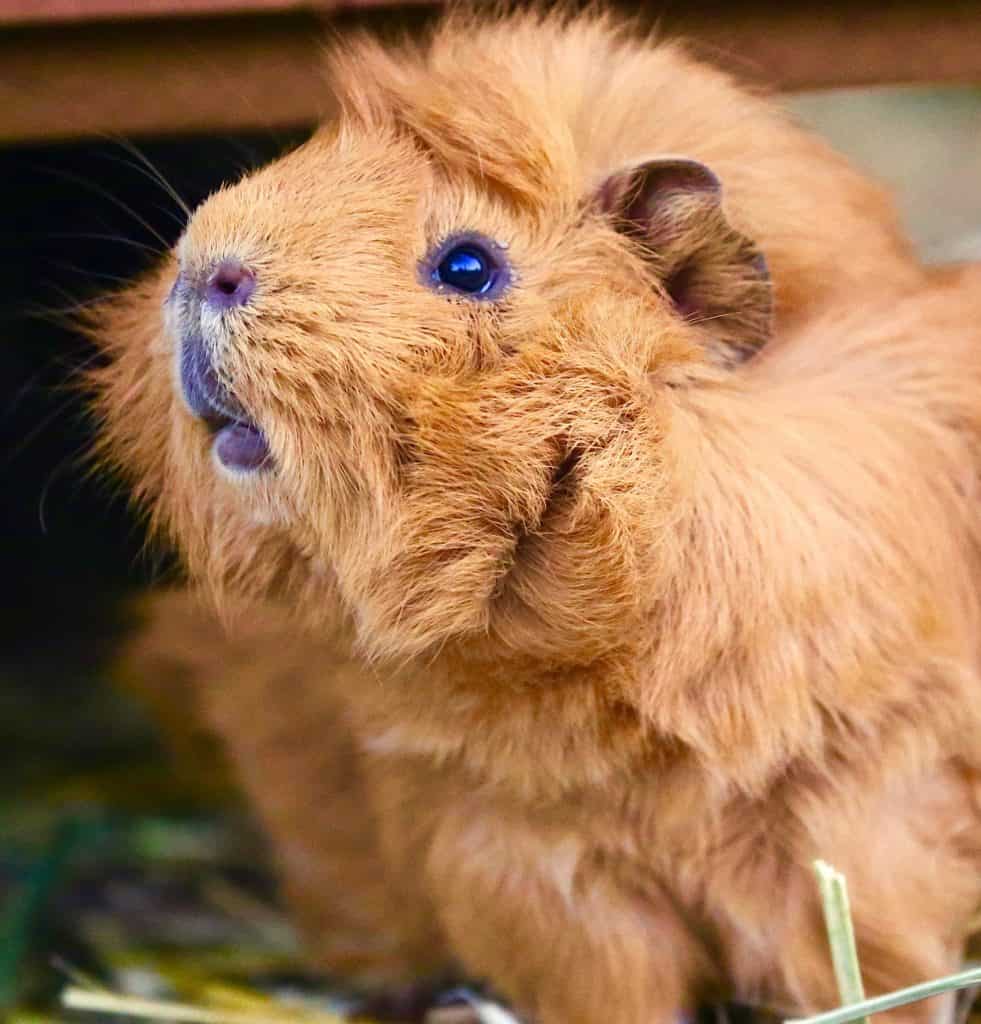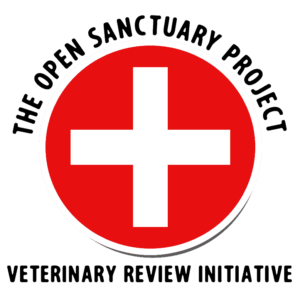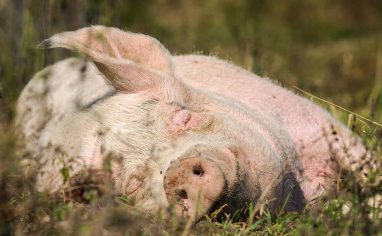
This resource was updated as part of the veterinary review process. It was originally published on April 14, 2021.

Veterinary Review Initiative
This resource has been reviewed for accuracy and clarity by a qualified Doctor of Veterinary Medicine with farmed animal sanctuaryAn animal sanctuary that primarily cares for rescued animals that were farmed by humans. experience as of December 2023. Check out more information on our Veterinary Review Initiative here!
Cavy?
Wondering why we are using the term ‘cavy’ instead of ‘guinea pig’ throughout this resource? Check out our explanation here.
Much like the common advice given to humans, it’s important to regularly evaluate the health of cavies with a routine health checkThe Open Sanctuary Project uses the term "health check" to describe health evaluations performed by caregivers who are not licensed veterinarians. While regular health checks are an important part of animal care, they are not meant to be a replacement for a physical exam performed by a licensed veterinarian. rather than waiting until a cavy is showing signs of distress or illness. Conducting regular health checks will help you get to know what all aspects of a healthy cavy look and feel like and will also help you to establish a baseline for what is “normal” for each individual in your care. Not only this, but regular handling may help residents become more comfortable with restraint and human handling. Be prepared to check cavies over at least every six to eight weeks*! Cavies who spend time outdoors during fly season will need more regular checks to prevent dangerous issues like fly strike. For more information on why regular health checks are important, check out our resource here.
*A Health Check Every Six to Eight Weeks Means Daily Observation
Our recommendation to conduct routine health checks every six to eight weeks must be done in conjunction with daily observations. Caregivers should be trained to observe residents both for behaviors that are abnormal for the species and also for behaviors that are abnormal for each individual, keeping in mind issues that are common in a particular species and their warning signs. Thoughtful observation plays a crucial role in catching health issues before they progress into more serious situations. While this is true for all species, it is particularly true for cavies because many health conditions can result in them progressing very quickly from seemingly okay to critically ill. You can read more about daily observation for cavy health and well-being here.
Residents With Challenging Backgrounds
Close daily observation can be difficult with certain individuals or groups who come from challenging backgrounds. They may be more likely to hide signs of illness or injury or, depending on their setup, may not allow you to come close enough to them to thoroughly assess their well-being on a regular basis. Challenging backgrounds may include individuals who are not socialized, have lived feral, or were abused or malnourished. If you care for individuals who come from a challenging background, it is imperative to make time to foster a bond of trust so careful observation is possible. Adjusting the frequency of health checks may be necessary for these individuals until they exhibit signs that they feel safe and you are confident that close daily observation is possible.
New Resident? Conduct An Intake Evaluation!
If you are conducting an initial health evaluation on a new resident, check out our intake evaluation resource to learn about what you should check for and document!
Supplies
Before conducting a health check, it’s helpful to gather any supplies you may need and have them arranged nearby for easy access. Having everything you will likely need nearby can make the process go more smoothly and can reduce the amount of time the individual needs to be restrained. If you are performing a health check on someone with additional care needs, such as a resident with an overactive grease gland, you may need other supplies, like those to bathe and dry them. Otherwise, supplies to have on hand during cavy health checks include:
- Recordkeeping supplies
- Nail trimmers (such as small dog or cat nail trimmers or human nail clippers)
- Styptic powder or other blood stop product
- Gauze squares (non-sterile is typically fine, but there may be times when sterile gauze is necessary)
- Exam gloves
- Cavy-safe topical disinfectant (such as dilute chlorhexidine gluconate or dilute betadine)
- Saline flush
- Cavy-safe ointments or creams such as silver sulfadiazine cream 1% (SSD)
- Cotton-tipped applicators
- Mineral oil or olive oil
- Tweezers
- Scale
- Headlamp, penlight, or flashlight
- Washcloths and/or towels
- Brush
- Cavy-safe fly deterrent (during fly season)
Conducting The Health Check
Ask An Expert
Prior to regularly conducting cavy health checks, you should have a veterinarian or compassionate care expert give you hands-on training in order to be the best cavy health advocate possible. Being trained to rapidly distinguish abnormalities from normal anatomy and healthy conditions can be crucial in early health problem detection, and the sooner you are able to bring concerns to your veterinarian, the sooner they’ll be able to work towards making a diagnosis and recommending any necessary interventions!
When In Doubt…
Unless you are a qualified veterinarian or have been trained to handle specific conditions, The Open Sanctuary Project strongly advocates that you promptly report any concerns you find during the course of a health check to your veterinarian (if you aren’t sure if what you are seeing is cause for concern or not, a more experienced caregiverSomeone who provides daily care, specifically for animal residents at an animal sanctuary, shelter, or rescue. may be able to help you, but if you are ever in doubt, we recommend erring on the side of caution and reaching out to your veterinarian). You should be the resident’s advocate, not their doctor! Additionally, routine health checks performed by a caregiver are not meant to be a replacement for a veterinary exam. The goal is to catch potential signs of concern as early as possible so you can bring concerns to your veterinarian. If necessary, they can then perform a more in-depth physical examination of the individual and can conduct diagnostic testing as needed.
Before beginning the actual health check, it’s a good idea to observe the individual without restraining them. Take note of their behavior, activity level, breathing, general appearance, how they are standing, and how they are moving. You can read more about “normal” versus potentially concerning cavy resident observations here.
During regularly scheduled health checks, your goal is to check the cavy’s whole body in a systematic order. It’s helpful to have a general order and routine that you follow each time because this can help ensure you do not miss a step. We recommend finding a system and order that works for you.
Safe Restraint
Before attempting to conduct a health check, make sure you know how to safely hold a cavy. You can read more about safe restraint here.
Up next, we’ll go over important components of a cavy health check:
Ensure that the cavy’s nails are a reasonable length, trimming them as needed (usually at least every 6 weeks). Cavies have four nails on their front feet and three on their back, though some individuals may be polydactyl. Trimming a cavy’s nails is very similar to trimming a cat’s or dog’s nails. Like cats and dogs, cavies also have a sensitive area made of soft tissue in the center of their nail known as the quick. Cutting the quick by accident can be painful, bloody, and understandably stressful to the individual, so it’s important to be very mindful about how much you trim. In cavies with dark nails, the quick may be more difficult to identify, but shining a light underneath the nail can help illuminate the quick.
If you accidentally draw blood, you can use a styptic pencil, styptic powder (such as Quick Stop), or cornstarch to stop the bleeding. Lacking these tools, you can also use a piece of toilet paper or cotton ball as if you’d nicked yourself shaving! If the bleeding doesn’t stop, you can use the tip of your finger to apply pressure for up to a minute, repeating until any bleeding stops.
Male cavies, especially individuals who are older and unneutered, need a bit of extra attention paid to their penis and perineal sac. Properly checking and cleaning this area is something that should be shown to you – not because it’s necessarily difficult, but because of the importance of being thorough while being gentle and because proper restraint during the procedure is imperative. We recommend asking your veterinarian or a cavy care expert to demonstrate this procedure and talk you through doing it yourself, but if that’s not possible, there are numerous “boar cleaning” videos available online.
To check their penis, hold the cavy in a vertical position with their back supported and against your body, and apply gentle pressure to the area just above the genitals to get the penis to extend. The penis should be clean – any excessive smegma (which is typically a white creamy substance but can also harden into a solid mass), as well as any hair, hay, or other debris, should be very gently removed using a moistened cotton swab or washcloth. Gentle pressure applied to the sides of the penis will extend the penile stiles (which look like little prongs). If any bedding, hay, or hardened semen (also called “sperm rods” because it can harden into a rod shape that may protrude out of the penis) is built up in the urethra, this will be apparent during this part of the health check and should be gently removed.
Next, check the perineal sac (sometimes called the anal sac), which is located between the scrotal pouches. In older unneutered males, this pocket often becomes full of smegma, poop, and debris. This build-up is referred to as an impaction. To check this area, gently open the pocket just below the penis. If there is material present, you may be able to express it with gentle pressure, or you can use a cotton-tipped applicator and a little mineral oil to gently remove the contents. If you are struggling with thoroughly checking your male residents, be sure to work with your veterinarian or an experienced cavy care expert to learn the proper technique.
Unless they are a breed that normally has kinked fur or rosettes, their hair coat should be smooth and shiny. Look for bald patches/hair loss, which can have many causes, including external parasites. Hair loss or areas of very short hair could also be the result of barbering, where a cavy chews and pulls out their own hair or that of a companion. Barbering is often the result of boredom (such as a cavy living alone or cavies living in a barren space), but can also be due to other stressors or unhealthy social dynamics. Be sure to investigate the cause so you can address the issue. In female cavies, hair loss along their sides with no signs of itchiness could be a sign of follicular cysts.
Check long-haired cavies for mats in their hair. With the exception of hairless breeds, all cavies will benefit from at least weekly brushing, and this can be a great way for caregivers to bond with their cavy companions. Long-haired cavies will need to be brushed more often, perhaps even daily. If an individual is developing mats, be sure to re-evaluate your brushing schedule. If the hair on their bum is getting peed on, consider carefully trimming it.
Next, part their hair and check their skin, looking for dry, flaky skin, discoloration, crusts, or other issues. Lice are large enough to be seen with the naked eye, but the mites they are most commonly affected by are microscopic. Signs of a mite infection include scaly skin or yellow crusts.
Cavies can also get ringworm, which manifests as circular, scaly, bald patches, which typically start out on the nose or around the eyes or ears and can spread to the back. Ringworm is zoonotic, so be sure to wear gloves and protect your skin when handling a cavy with signs of ringworm.
In hairless cavies, be sure to check them over for any sign of skin irritation, which may indicate that their bedding or other elements of their living spaceThe indoor or outdoor area where an animal resident lives, eats, and rests. must be changed.
Though it may seem like an overwhelming amount of factors to be aware of, once you’ve gotten to know a cavy and what good cavy health looks like, you’ll be an excellent cavy health ally in no time!
Writing It All Down
As you may know, regular documentation is a critical part of responsible sanctuary animal care. In order to maximize the value of your cavy health checks, we’ve developed a free printable cavy health check form for sanctuaries and rescues!
SOURCES:
How To Perform A Health Check On Your Guinea Pig | Los Angeles Guinea Pig Rescue
What Do I Need To Know About My Guinea Pigs’ Health? | RSPCA
How To Do Easy, 10 Minute Weekly Guinea Pig Health Checks | Happy Cavy
Guinea Pig Nail Clipping Instruction | Los Angeles Guinea Pig Rescue
What Is Boar Glue And What Is A Sperm Rod? | Los Angeles Guinea Pig Rescue
Anal Impaction | The Mayne Veterinary Clinic
Grooming Guinea Pigs | Companion Animals Extension
How to Trim Guinea Pig Teeth: 4 Vet-Approved Tips | Pet Keen
Ovarian Cysts In Guinea Pigs | Arizona Exotic Animal Hospital
References To Outside Organizations?
This resource contains links or photos provided by an outside animal-focused organization. You can learn about our organization’s position on endorsements here!








